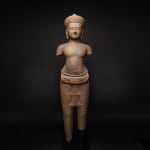Khmer Standing Vishnu, 1100 CE - 1200 CE
Stone
116.8 x 33 cm
46 x 13 in
46 x 13 in
HK.3
Further images
-
(View a larger image of thumbnail 1
)

-
(View a larger image of thumbnail 2
)

-
(View a larger image of thumbnail 3
)

-
(View a larger image of thumbnail 4
)

-
(View a larger image of thumbnail 5
)

-
(View a larger image of thumbnail 6
)

-
(View a larger image of thumbnail 7
)

-
(View a larger image of thumbnail 8
)

-
(View a larger image of thumbnail 9
)

-
(View a larger image of thumbnail 10
)

-
(View a larger image of thumbnail 11
)

-
(View a larger image of thumbnail 12
)

-
(View a larger image of thumbnail 13
)

This is an impressive sculpture of Vishnu from the Khmer empire. The statue combines a simplification of the masses with great refinement of detail. Standing authoritatively facing forward, the figure...
This is an impressive sculpture of Vishnu from the Khmer empire. The statue combines a simplification of the masses with great refinement of detail. Standing authoritatively facing forward, the figure wears a royal crown which is delicately carved with hollow-out patterns. The features are elegantly presented on the square face: the forehead is high and broad; the eyes wide-set, and gazing downwards; the nose and mouth wide; the lips full and sensuous; and the chin dainty and rounded. Three intaglio rings encircle the neck, creating the fleshy folds that frequently are described in canonical Buddhist texts. Revealing his muscular broad chest, the figure wears a sampot on his lower body, which is tied around his waist with a double anchor belt and a pleated reverted front part. Flaring outward, it drapes downwards covering his thighs. The back of the sculpture is plain and without representational details, except for the back of the head, which reveals locks of hair under the royal crown. Around its periphery, the sculpture's edges are extremely smooth at the shoulders and down the sides.
Since Angkor was a Hindu-Buddhist empire, its stylistic features draw from both Hindu and Buddhist iconography and symbolism. During the early period of the empire, there was a trend to transform Buddhas in the manner of a chakra-vartin, that is the crowned form, instead of the conventional monastic form, as shown by a chakra-vartin which is on display in Musee Guimet (MG 18127). This form is adopted to construct the head of this sculpture of Vishnu. It is highly possible to be constructed during the reign of King Suryavarman II, who himself was a Vaishnavite. This captivating sculpture shows exquisite craftsmanship which is compulsory for a royal piece.
Since Angkor was a Hindu-Buddhist empire, its stylistic features draw from both Hindu and Buddhist iconography and symbolism. During the early period of the empire, there was a trend to transform Buddhas in the manner of a chakra-vartin, that is the crowned form, instead of the conventional monastic form, as shown by a chakra-vartin which is on display in Musee Guimet (MG 18127). This form is adopted to construct the head of this sculpture of Vishnu. It is highly possible to be constructed during the reign of King Suryavarman II, who himself was a Vaishnavite. This captivating sculpture shows exquisite craftsmanship which is compulsory for a royal piece.












